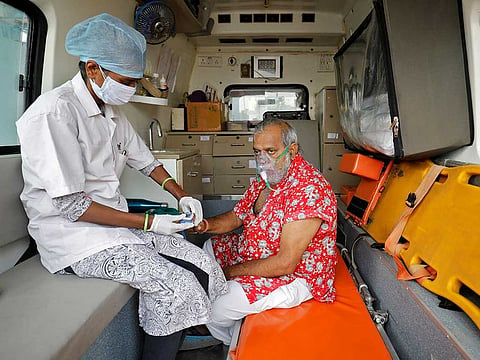India pays the price of Covid complacency
The need of the hour now is for everyone to unite for the battle that lies ahead

With 346,786 new cases Saturday, India has recorded nearly a million infections in three days. But these numbers do not reveal the full extent of the horror and human tragedy playing out across the world’s largest democracy.
Today’s heart-breaking scenes are a far cry from earlier this year, when new cases fell to 11,000, vaccines were being exported around the world, and the Indian health minister claimed the country was “in the endgame” of the pandemic.
The massive new surge since then has been blamed on a new double-mutant strain — and reportedly another triple-mutant one — that has wreaked havoc across the country.
The stakes of India’s catastrophic rise in infections are too high in an inter-connected world, and every possible effort must therefore be mounted to bring the Covid crisis in India under control at the earliestGulf News
But government complacency despite repeated warnings from health experts, poor infection control, “superspreader” events such as the gathering of 4.6 million pilgrims for the Kumbh Mela and massively crowded election rallies addressed by top politicians have also been cited for further aggravating the crisis.
An eight-phase election in West Bengal, for instance, cannot be justified during the pandemic, and the Indian Election Commission’s pyrrhic damage-control actions have come too late.
Whether it’s complacency, lack of preparedness or bureaucratic failure, there must be a full introspection into what went wrong. With funeral pyres burning all over several cities and patients dying as oxygen supplies run out, there must be answers and accountability for this calamity.
However, the time for that is not now. The need of the hour now is for everyone to unite across the political and social spectrum for the battle that lies ahead – every helping hand counts at this critical juncture.
The government has swung into action, deploying trains and the air force to transport oxygen supplies to hard-hit areas, deregulating its vaccination strategy and procuring oxygen plants from Germany. But it needs to do much more — starting with a cohesive strategy to deal with this monumental crisis.
National oxygen distribution policy
There must be a national oxygen distribution policy which prioritises hospitals and healthcare over industry. It is equally important to keep running India’s vaccination process — which is slowing down due to a supply shortage. It’s the vaccine that seems to have so far prevented a mass-scale reinfection of people.
The government has rightly said that lockdown is the last resort since it has a devastating impact on livelihoods. Everyone must thus rally together to avoid a total lockdown and keep the economy running – state governments and the federal apparatus must work in sync to make this happen. Finally, people need to abide by the rules in the first place – there’s pretty much nothing any government or doctor can do if citizens rampantly flout basic protocol.
The stakes of India’s catastrophic rise in infections are too high in an inter-connected world, and every possible effort must therefore be mounted to bring the Covid crisis in India under control at the earliest.
Sign up for the Daily Briefing
Get the latest news and updates straight to your inbox







